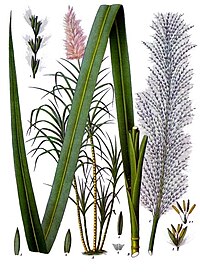
Agronomic Response, Weed Smothering Efficiency and Economic Feasibility of Sugarcane and Legume Intercropping System in Tropical India
Sign Up to like & getrecommendations! Published in 2018 at "Sugar Tech"
DOI: 10.1007/s12355-018-0689-9
Abstract: Intercropping helps diversification of crop production to fulfill diversified need of farmers. Sugarcane because of its initial slow growth can comfortably accommodate short-duration crops in between the rows. With the aim of assessing the profitability… read more here.
Keywords: soybean; sugarcane; sugarcane soybean; intercropping system ... See more keywords

Biochar and crushed straw additions affect cadmium absorption in cassava-peanut intercropping system.
Sign Up to like & getrecommendations! Published in 2019 at "Ecotoxicology and environmental safety"
DOI: 10.1016/j.ecoenv.2018.10.003
Abstract: Cassava (Manihot esculenta Crantz) intercropped with peanut (Arachis hypogaea) has good complementary effects in time and space. In the field plot test, the land equivalent ratio (LER) of cassava-peanut intercropping system was 1.43, showing obvious… read more here.
Keywords: biochar; cassava peanut; crushed straw; cassava ... See more keywords

Productivity and water use of organic wheat–chickpea intercropping system under limited moisture conditions in Northwest India
Sign Up to like & getrecommendations! Published in 2017 at "Renewable Agriculture and Food Systems"
DOI: 10.1017/s1742170517000370
Abstract: Abstract Intercropping of legumes in cereals and manuring are important measures to sustain soil fertility and enhance crop productivity in general and under organic and limited moisture conditions in particular. This study evaluated different wheat… read more here.
Keywords: wheat; wheat chickpea; chickpea intercropping; intercropping system ... See more keywords

Targeted metabolomics analysis of fatty acids in soybean seeds using GC-MS to reveal the metabolic manipulation of shading in the intercropping system
Sign Up to like & getrecommendations! Published in 2017 at "Analytical Methods"
DOI: 10.1039/c7ay00011a
Abstract: A field microenvironment varies with intercropping ecological planting patterns, especially its light conditions. Due to light reflection and absorption by maize leaves, spectral irradiance, red/far-red (R/FR) ratio, and photosynthetic active radiation (PAR) of the soybean… read more here.
Keywords: soybean; analysis; fatty acid; fatty acids ... See more keywords

Antimicrobial Terpenes Suppressed the Infection Process of Phytophthora in Fennel-Pepper Intercropping System
Sign Up to like & getrecommendations! Published in 2022 at "Frontiers in Plant Science"
DOI: 10.3389/fpls.2022.890534
Abstract: The interactions between non-host roots and pathogens may be key to the inhibition of soilborne pathogens in intercropping systems. Fennel (Foeniculum vulgare) can be intercropped with a wide range of other plants to inhibit soilborne… read more here.
Keywords: intercropping system; infection; fennel; terpene compounds ... See more keywords

Nitrogen Fertilization in a Faba Bean–Wheat Intercropping System Can Alleviate the Autotoxic Effects in Faba Bean
Sign Up to like & getrecommendations! Published in 2023 at "Plants"
DOI: 10.3390/plants12061232
Abstract: Continuous cultivation of the faba bean will lead to its autotoxicity. Faba bean–wheat intercropping can effectively alleviate the autotoxicity of the faba bean. In order to investigate the autotoxicity of water extracts of various parts… read more here.
Keywords: intercropping system; faba bean; bean wheat; wheat intercropping ... See more keywords